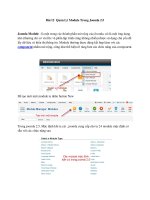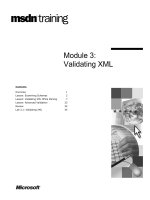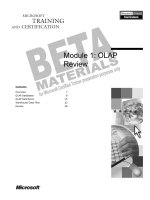HACCP methodology module
Bạn đang xem bản rút gọn của tài liệu. Xem và tải ngay bản đầy đủ của tài liệu tại đây (164.95 KB, 3 trang )
TCCQS Ev.3 Global Audit Program
HACCP Methodology Module
Document nr.: GAP-COM-HM CONFIDENTIAL Revision date:01/01/2006
Edition nr.: 3 Page 1 of 3 Revised by: TC
This module serves as a guide to the auditor in completing the assessment of the HACCP plan during the audits. The auditor will
determine whether or not the facility is complying with the specifications and requirements of The Coca-Cola Company by
completing this audit module. This module is not intended to be used as a HACCP Certification Audit Tool.
Plant:
Date:
Auditor(s):
1) Questionnaire:
1. Is there a HACCP study in place? 1
2. Does the organization meet HACCP program requirements? 1
3. Is the HACCP team assembled? 1
4. Are all type of products described properly with intended use? 2
5. Are there flow diagrams available? 2
6. Does the operation have a Hazard Analysis? 2
7. Are all CCPs identified properly? 2
8. Are monitoring procedures established for each CCP? 2
9. Are corrective actions addressed properly for each CCP? 3
10. Are verification and validation procedures established? 3
11. Are documentation and record keeping requirements established? 3
2) Reference Standards List:
Beverage Operations Manual
• BO-RQ-770 Hazard Analysis and Critical Control Points (HACCP) Program
TCCQS updates are captured till December 15, 2005
3) Specifications and Requirements Summary
:
Specifications / Requirements
General
1 Is there a HACCP study in place?
BO-RQ-770
• Study is done by following the seven-principle, twelve-step model described in Codex
Alimentarius and relevant local authority.
• All prerequisite requirements are met prior to application e.g. sanitation, personnel
hygiene, GMP, training etc.(Refer to document BO-RQ-770 for prerequisite
requirements)
2 Does the organization meet HACCP
program requirements?
BO-RQ-770
• Full commitment and involvement of management and the workforce
• Reviewed at least annually
• Updates take place each time a change is made to the process, product, or equipment
• HACCP must be defined separately by product type, process, line and location.
• All personnel involved must be trained in HACCP principles.
3 Is the HACCP team assembled?
Typical HACCP team includes representatives
from engineering, production, sanitation, quality,
BO-RQ-770
• A local HACCP coordinator or a team leader is appointed.
• HACCP team consists of individuals with the knowledge of process and product and
expertise to develop an effective program.
Yes Div No
TCCQS Ev.3 Global Audit Program
HACCP Methodology Module
Document nr.: GAP-COM-HM CONFIDENTIAL Revision date:01/01/2006
Edition nr.: 3 Page 2 of 3 Revised by: TC
and microbiology.
• Scope is defined by HACCP team
4 Are all type of products described
properly with intended use?
BO-RQ-770
• HACCP team develops a full description of the product including:
- Product name
- Relevant food safety info (physical, chemical structure, composition,
substances food contact materials)
- Process / preservation method
- Packaging
- Distribution and storage (duration and shelf-life, storage conditions,
distribution and transportation means)
- Normal and expected use of the product and any vulnerable groups of
population
5 Are there flow diagrams available?
BO-RQ-770
• Flow diagrams covering each step in the process within the scope are available.
• Diagrams include outsourced processes, subcontracted work, rework, recycling and
waste removal.
• Flow diagrams are confirmed to be correct by comparing them to actual operations.
6 Does the operation have a Hazard
Analysis?
A significant food safety hazard in one operation
may not be significant in an other operation
producing the same or similar product.
A Supportive Safety Measure may be a process ,
procedure or component of a functioning
prerequisite program such as GMP.
BO-RQ-770
• All potential biological, chemical and/or physical hazards are listed and categorized.
• A hazard analysis is conducted to identify which hazards are of a nature that their
prevention, elimination or reduction to acceptable level is essential.
• Each hazard is evaluated against:
- Severity or seriousness
- Likeliness to occur
- Scientific data about the nature of the hazard
- Consumer complaints data
- Effectiveness of existing control measures
• Records of deliberations and rational developed during the analysis is maintained.
• Control measures are decided and categorized a “Critical Control Measures” or
Supportive Control Measures”
• Where a potential hazard is specifically addressed in a HACCP plan, it is categorized as
“significant food safety hazard” and a “Critical Control Measure” is established for each
CCP.
• Analysis is conducted for each product type and production line and repeated prior to
any change in ingredients, packaging materials, product use, formulation and production
line layout.
7 Are all CCPs identified properly?
At a process step where control is necessary for a
significant hazard, yet no control measure exists,
the product or process must be modified at that
step, or at any earlier or later stage, to include a
control measure.
More than one control measure may control a
significant hazard; a single Critical control
measure may control more than one.
In some cases more than one Critical limit may
be elaborated at a CCP.
BO-RQ-770
• Each significant hazard is addressed in determining CCPs.
• Identification for each CCP is accurate and complete.
• Each CCP is
- Justifiable
- Validated
- Measurable
- Carefully developed
to ensure its effectiveness.
• Records for each CCP determination are available.
• CCPs are monitored and the procedure /method is documented in HACCP plan.
• HACCP team specified, validated and documented the justification and measurement
criteria for critical limits at each CCP.
• Critical limits are scientifically based and measurable.
8 Are monitoring procedures established
for each CCP?
When feasible, continuous monitoring is always
preferred.
BO-RQ-770
• All activities associated with control of CCP and the actions to take when any deviation
occurs are addressed in HACCP plan.
• Each CCP is effectively monitored.
• Monitoring procedure for a CCP includes
- Scheduled physical, chemical or microbiological measurement or
observation of a CCP relative to its critical limit to indicate control of the
process
- Detection of loss of control at the CCP and definition of how to be monitored
- Evaluation of the monitoring data by a responsible person with the
knowledge and authority to carry out corrective actions
- Sufficient frequency of monitoring , if not continuous
• All records and document associated with CCP monitoring are dated and signed by the
person responsible for monitoring and by a management representative trained in
HACCP for evaluation (typically HACCP coordinator)
• Personnel monitoring the CCP fully understand their purpose and importance and
trained in the monitoring technique that he/she is responsible.
TCCQS Ev.3 Global Audit Program
HACCP Methodology Module
Document nr.: GAP-COM-HM CONFIDENTIAL Revision date:01/01/2006
Edition nr.: 3 Page 3 of 3 Revised by: TC
9 Are corrective actions addressed
properly for each CCP?
BO-RQ-770
• Specific corrective actions are developed and documented for each CCP.
• At a minimum, these activities are specified in HACCP plan as:
- what to do when a deviation occurs
- who is responsible for implementing corrective actions
- the development and maintenance of a record of actions taken and results.
10 Are verification and validation
procedures established?
BO-RQ-770
• Verification frequency for HACCP plan is max. 12 months, and also takes place when
changes occur that could affect hazard analysis or HACCP plan.
• Verification procedure includes:
- Review of hazard analysis documentation
- Review of audit results, which review occurs within seven days from the day
the records are made
- Review of process monitoring data for confirmation that CCPs are kept
under control
- Calibration of process monitoring instruments
- Communication of verification results to the HACCP team.
• Validation of HACCP program includes actions to confirm the elements of the HACCP
plan are effective.
11 Are documentation and record keeping
requirements established?
BO-RQ-770
• Establish, implement and maintain documentation and record keeping procedures
appropriate to the nature and size of the operation.
• Documentation includes:
- Hazard analysis
- CCP determination
- Critical limit determination
• Records includes:
- CCP monitoring activity
- Deviations and associated corrective actions
- Modifications to the HACCP program
- Verification activities
• HACCP documentation is included as a part of the organization’s Product Release
Authorization plan and reviewed by the HACCP coordinator. Product release includes
confirmation that no Deviation occurred.
• Record retention duration is established according to company and local requirements.
4) Comments & Remarks
:
_ _ _ _ _ _ _ _ _ _ _ _ _ _ _ _ _ _ _ _ _ _ _ _ _ _ _ _ _ _ _ _ _ _ _ _ _ _ _ _ _ _ _ _ _ _ _ _ _ _ _ _ _ _ _ _ _ _ _ _ _ _ _ _ _ _ _ _
_ _ _ _ _ _ _ _ _ _ _ _ _ _ _ _ _ _ _ _ _ _ _ _ _ _ _ _ _ _ _ _ _ _ _ _ _ _ _ _ _ _ _ _ _ _ _ _ _ _ _ _ _ _ _ _ _ _ _ _ _ _ _ _ _ _ _ _
_ _ _ _ _ _ _ _ _ _ _ _ _ _ _ _ _ _ _ _ _ _ _ _ _ _ _ _ _ _ _ _ _ _ _ _ _ _ _ _ _ _ _ _ _ _ _ _ _ _ _ _ _ _ _ _ _ _ _ _ _ _ _ _ _ _ _ _
_ _ _ _ _ _ _ _ _ _ _ _ _ _ _ _ _ _ _ _ _ _ _ _ _ _ _ _ _ _ _ _ _ _ _ _ _ _ _ _ _ _ _ _ _ _ _ _ _ _ _ _ _ _ _ _ _ _ _ _ _ _ _ _ _ _ _ _
_ _ _ _ _ _ _ _ _ _ _ _ _ _ _ _ _ _ _ _ _ _ _ _ _ _ _ _ _ _ _ _ _ _ _ _ _ _ _ _ _ _ _ _ _ _ _ _ _ _ _ _ _ _ _ _ _ _ _ _ _ _ _ _ _ _ _ _
_ _ _ _ _ _ _ _ _ _ _ _ _ _ _ _ _ _ _ _ _ _ _ _ _ _ _ _ _ _ _ _ _ _ _ _ _ _ _ _ _ _ _ _ _ _ _ _ _ _ _ _ _ _ _ _ _ _ _ _ _ _ _ _ _ _ _ _
_ _ _ _ _ _ _ _ _ _ _ _ _ _ _ _ _ _ _ _ _ _ _ _ _ _ _ _ _ _ _ _ _ _ _ _ _ _ _ _ _ _ _ _ _ _ _ _ _ _ _ _ _ _ _ _ _ _ _ _ _ _ _ _ _ _ _ _
_ _ _ _ _ _ _ _ _ _ _ _ _ _ _ _ _ _ _ _ _ _ _ _ _ _ _ _ _ _ _ _ _ _ _ _ _ _ _ _ _ _ _ _ _ _ _ _ _ _ _ _ _ _ _ _ _ _ _ _ _ _ _ _ _ _ _ _
_ _ _ _ _ _ _ _ _ _ _ _ _ _ _ _ _ _ _ _ _ _ _ _ _ _ _ _ _ _ _ _ _ _ _ _ _ _ _ _ _ _ _ _ _ _ _ _ _ _ _ _ _ _ _ _ _ _ _ _ _ _ _ _ _ _ _ _
_ _ _ _ _ _ _ _ _ _ _ _ _ _ _ _ _ _ _ _ _ _ _ _ _ _ _ _ _ _ _ _ _ _ _ _ _ _ _ _ _ _ _ _ _ _ _ _ _ _ _ _ _ _ _ _ _ _ _ _ _ _ _ _ _ _ _ _
_ _ _ _ _ _ _ _ _ _ _ _ _ _ _ _ _ _ _ _ _ _ _ _ _ _ _ _ _ _ _ _ _ _ _ _ _ _ _ _ _ _ _ _ _ _ _ _ _ _ _ _ _ _ _ _ _ _ _ _ _ _ _ _ _ _ _ _
_ _ _ _ _ _ _ _ _ _ _ _ _ _ _ _ _ _ _ _ _ _ _ _ _ _ _ _ _ _ _ _ _ _ _ _ _ _ _ _ _ _ _ _ _ _ _ _ _ _ _ _ _ _ _ _ _ _ _ _ _ _ _ _ _ _ _ _
_ _ _ _ _ _ _ _ _ _ _ _ _ _ _ _ _ _ _ _ _ _ _ _ _ _ _ _ _ _ _ _ _ _ _ _ _ _ _ _ _ _ _ _ _ _ _ _ _ _ _ _ _ _ _ _ _ _ _ _ _ _ _ _ _ _ _ _









